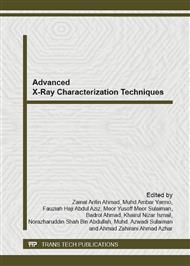p.7
p.12
p.17
p.22
p.28
p.35
p.40
p.45
p.50
Determination of Crystallite Size in Synthetic and Natural Hydroxyapatite: A Comparison between XRD and TEM Results
Abstract:
The study reported here focuses on the crystallite size of synthetic hydroxyapatite (HAp) obtained using sol-gel method and natural HAp obtained by processing the natural bone. Human and camel bones were used for obtaining natural HAp. HAp particles were produced, characterized and compared for their crystallite size. The average crystallite size of the samples was derived from the X-ray Diffraction (XRD) data using the Scherrer formula and a new method called modified scherrer equation that was came by developing the Scherrer formula. The results showed the crystallite size of HAp gained from different sources were different. The crystallite size of synthetic, human and camel bone-derived HAp, were approximately 18, 23 and 29 nanometer, respectively. These values were less than those obtained from TEM images. It seems that calculated crystallite size using XRD data and Scherrer equations is less than the real size. This important finding must be taken into consideration in applying Scherrer equations.
Info:
Periodical:
Pages:
28-34
Citation:
Online since:
December 2012
Price:
Сopyright:
© 2013 Trans Tech Publications Ltd. All Rights Reserved
Share:
Citation:


